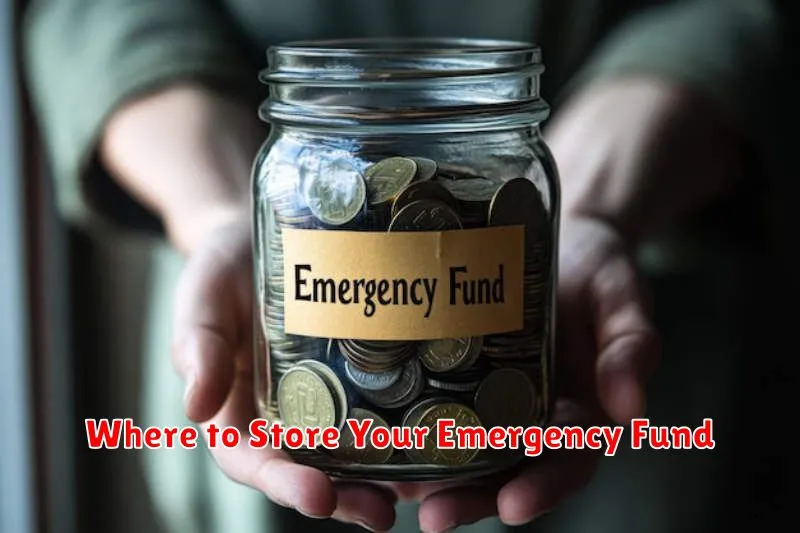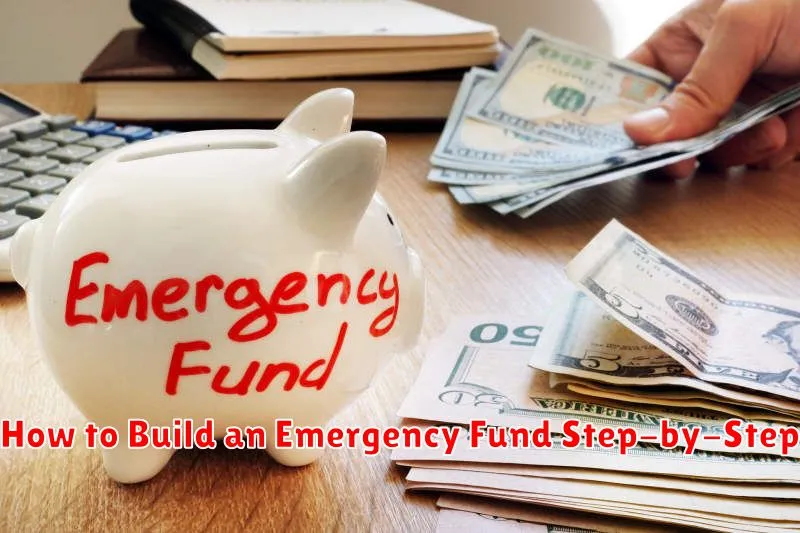Building an emergency fund is a crucial step towards achieving financial security. Unexpected expenses, such as job loss, medical emergencies, or car repairs, can arise at any time. Without a financial safety net, these unforeseen events can quickly lead to debt and financial hardship. A well-structured emergency fund provides a buffer against these unexpected costs, allowing you to navigate challenging times without jeopardizing your financial stability. This comprehensive guide will provide a step-by-step approach to building a robust emergency fund tailored to your individual needs. Learn how to assess your financial situation, set realistic saving goals, and develop sustainable saving strategies.
By following these proven steps, you can create a solid financial foundation and gain peace of mind knowing you are prepared for whatever life throws your way. From determining the ideal emergency fund amount to automating your savings and exploring different saving vehicles, this article will equip you with the knowledge and tools necessary to build a secure financial future. Begin your journey towards financial freedom today and take control of your finances by establishing an emergency fund. Start building your emergency fund now and protect yourself from future financial uncertainties.
Why Everyone Needs an Emergency Fund
An emergency fund is a crucial safety net for unexpected financial hardships. Life is full of unforeseen events, from sudden job loss and medical emergencies to urgent home or car repairs. Without readily available funds, these situations can quickly spiral into debt, impacting your credit score and overall financial well-being. Having an emergency fund provides a buffer against these unforeseen circumstances, allowing you to address them without resorting to high-interest credit cards or loans.
Financial security and peace of mind are the primary benefits of maintaining an emergency fund. Knowing you have resources to cover unexpected expenses reduces stress and anxiety associated with financial uncertainties. It empowers you to navigate challenging situations with greater confidence and control, preventing small problems from becoming major crises. Furthermore, an emergency fund can provide the freedom to pursue opportunities or make necessary changes in your life, such as switching careers or relocating, without the fear of financial instability.
Building an emergency fund takes discipline and planning. Start small and aim to save consistently. A commonly recommended target is three to six months of essential living expenses. While this may seem daunting, even small, regular contributions will accumulate over time. Consider automating transfers to a separate savings account dedicated solely to your emergency fund. This disciplined approach will ensure consistent growth and limit the temptation to dip into the funds for non-emergency purposes.
How Much Should You Save?
Determining the right amount to save depends on individual circumstances, but a general rule of thumb is to strive for at least 20% of your after-tax income. This 20% can be further broken down: aim for 5% to be readily available in a liquid account for emergencies, and allocate the remaining 15% towards longer-term goals like retirement or a down payment on a house.
While 20% is a solid target, it’s important to be flexible. Factors such as existing debt, income level, and short-term financial goals can influence how much you can realistically save. If 20% feels unattainable, start smaller and gradually increase your savings rate as your financial situation improves. Even small, consistent contributions can accumulate significantly over time thanks to the power of compound interest.
It’s crucial to prioritize saving. Make it a non-negotiable part of your budget, similar to paying essential bills. Automating your savings through regular transfers to a savings or investment account can simplify the process and help you stay on track. Regularly review your budget and adjust your savings goals as needed to ensure they align with your current financial situation and future aspirations.
Start With Small, Consistent Goals
Setting ambitious goals can be inspiring, but often leads to frustration and discouragement if they’re too difficult to achieve quickly. Instead, focus on establishing small, manageable goals that you can consistently achieve. This builds momentum and reinforces positive habits. Small wins contribute to larger successes over time, making the overall journey less daunting and more rewarding.
Consistency is key to achieving any goal, large or small. Regularly engaging with your objectives, even in small increments, creates positive reinforcement and helps solidify new habits. For example, if your goal is to improve your fitness, start with short, daily walks rather than aiming for an intense workout regimen right away. This approach fosters a sense of accomplishment and makes it easier to stick with your plan.
By setting small, achievable goals and working towards them consistently, you build a foundation for lasting success. This method promotes a sense of self-efficacy, making you believe in your ability to accomplish larger goals in the future. Remember to celebrate these small victories along the way – they are important stepping stones towards reaching your overall aspirations.
Where to Store Your Emergency Fund

An emergency fund serves as a financial safety net, providing a readily available source of funds for unexpected expenses or disruptions in income. Therefore, accessibility, security, and preservation of capital are paramount when choosing where to keep it. Avoid investing your emergency fund in volatile assets like stocks or cryptocurrency. Instead, prioritize accounts that offer easy access and minimal risk of loss.
High-yield savings accounts are an excellent choice for storing emergency funds. They offer higher interest rates than traditional savings accounts, helping your money grow slightly while remaining easily accessible through online transfers or ATM withdrawals. Money market accounts are another suitable option, often providing higher interest rates and check-writing capabilities, though they may have higher minimum balance requirements. Finally, consider certificates of deposit (CDs) for portions of your emergency fund you don’t anticipate needing immediately. While CDs offer higher interest rates, they have fixed terms, and withdrawing funds early may incur penalties. Choose shorter-term CDs for greater flexibility.
Regardless of your chosen account, ensure it’s FDIC-insured (or NCUA-insured if it’s a credit union) for up to $250,000 per depositor, per insured bank, for each account ownership category. This insurance protects your money in the unlikely event of bank failure. Keep your emergency fund separate from your regular checking account to avoid accidental spending and make it easier to track your progress towards your savings goals.
Best Bank Accounts for Emergency Funds
Building an emergency fund is a crucial step towards financial security. A dedicated account for these funds helps ensure you have readily available cash for unexpected expenses like medical bills, car repairs, or job loss. When choosing an account, prioritize easy access to your money and FDIC insurance for protection. Look for accounts with minimal fees and consider the interest rate offered, though high returns shouldn’t be the primary focus for an emergency fund.
Several types of accounts can be suitable for your emergency fund. High-yield savings accounts often offer competitive interest rates and allow easy access to funds through ATM withdrawals or transfers. Money market accounts typically offer higher interest rates than traditional savings accounts and may come with debit card access, though they may have higher minimum balance requirements. While certificates of deposit (CDs) offer higher interest rates, accessing your money before maturity can incur penalties, making them less ideal for emergency funds unless you are building a longer-term portion of your reserves.
Choosing the right account depends on your individual needs. Consider factors like how quickly you need access to the money, the minimum balance requirements, and the offered interest rate. Ultimately, the best emergency fund account is one that allows you to access your funds easily when needed while offering some return on your savings.
What Counts as an Emergency?
A medical emergency is any condition that poses an immediate threat to your health and requires immediate medical attention. These situations can be life-threatening or cause serious complications if not treated quickly. Some examples include difficulty breathing, severe chest pain, loss of consciousness, heavy bleeding, sudden vision changes, or severe allergic reactions.
It’s important to distinguish between urgent care and emergency care. Urgent care centers are equipped to handle less severe conditions that still require prompt attention but aren’t life-threatening. Examples include minor cuts, sprains, infections, or the flu. While these situations require treatment, they generally don’t pose the same immediate risk as a true emergency.
If you are uncertain whether your situation is an emergency, it’s always best to err on the side of caution and seek immediate medical help. Dialing 911 is the fastest way to access emergency services and receive necessary care. Trained dispatchers can assess your situation and send appropriate help quickly. Remember, delaying treatment for a true emergency can have serious consequences.
Common Mistakes to Avoid
One of the most common mistakes people make is failing to plan adequately. Whether it’s a project, a trip, or even a simple task, lack of planning can lead to unnecessary stress and wasted time. Taking a few moments to outline your goals, gather necessary resources, and anticipate potential challenges can significantly improve your chances of success. Another frequent error is neglecting to communicate effectively. Misunderstandings and conflicts often arise from poor communication, so it’s crucial to be clear, concise, and considerate when interacting with others.
Procrastination is another major pitfall that many people struggle with. Putting off important tasks until the last minute can result in rushed work, missed deadlines, and increased anxiety. Developing good time management skills and prioritizing responsibilities are essential for overcoming procrastination and achieving your goals. Remember to break down large tasks into smaller, more manageable steps to avoid feeling overwhelmed.
Finally, failing to learn from mistakes is a critical oversight that hinders growth and progress. Instead of viewing mistakes as failures, embrace them as learning opportunities. Analyze what went wrong, identify areas for improvement, and apply those lessons to future endeavors. This continuous process of reflection and adaptation is crucial for personal and professional development.
Maintaining the Fund Over Time
Maintaining a fund requires ongoing attention and strategic decision-making. Regular contributions are crucial to ensure the fund’s continued growth and ability to meet its objectives. This might involve establishing a consistent investment schedule or implementing automated deposits. Additionally, periodic reviews of the fund’s performance are essential. These reviews should assess the fund’s alignment with its stated goals and identify any necessary adjustments to the investment strategy.
Monitoring expenses is another key component of fund maintenance. High fees and administrative costs can erode returns over time, diminishing the overall value of the fund. It’s essential to understand all costs associated with the fund and to actively seek ways to minimize unnecessary expenses. This could involve comparing fees with similar funds, negotiating lower rates, or exploring alternative investment options.
Finally, adapting to changing circumstances is paramount. Market fluctuations, economic shifts, and changes in investor objectives can all impact the fund’s performance and relevance. Regularly reviewing and adjusting the investment strategy, risk tolerance, and asset allocation can help ensure the fund remains aligned with its long-term goals and effectively addresses any unforeseen challenges.

